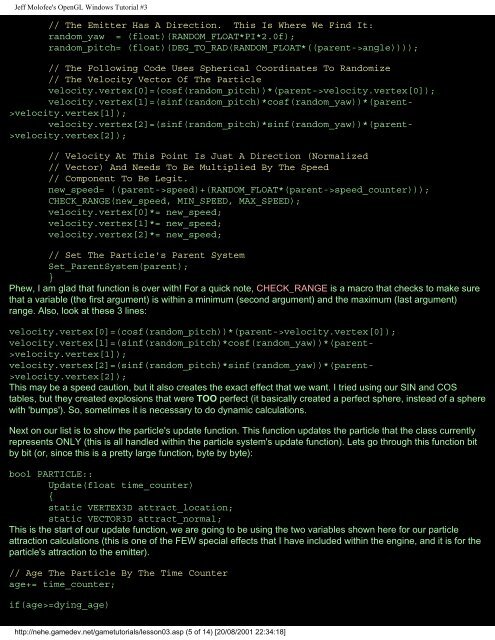Trent Polack's OpenGL Game Programming Tutorials
Trent Polack's OpenGL Game Programming Tutorials
Trent Polack's OpenGL Game Programming Tutorials
Create successful ePaper yourself
Turn your PDF publications into a flip-book with our unique Google optimized e-Paper software.
Jeff Molofee's <strong>OpenGL</strong> Windows Tutorial #3<br />
// The Emitter Has A Direction. This Is Where We Find It:<br />
random_yaw = (float)(RANDOM_FLOAT*PI*2.0f);<br />
random_pitch= (float)(DEG_TO_RAD(RANDOM_FLOAT*((parent->angle))));<br />
// The Following Code Uses Spherical Coordinates To Randomize<br />
// The Velocity Vector Of The Particle<br />
velocity.vertex[0]=(cosf(random_pitch))*(parent->velocity.vertex[0]);<br />
velocity.vertex[1]=(sinf(random_pitch)*cosf(random_yaw))*(parent-<br />
>velocity.vertex[1]);<br />
velocity.vertex[2]=(sinf(random_pitch)*sinf(random_yaw))*(parent-<br />
>velocity.vertex[2]);<br />
// Velocity At This Point Is Just A Direction (Normalized<br />
// Vector) And Needs To Be Multiplied By The Speed<br />
// Component To Be Legit.<br />
new_speed= ((parent->speed)+(RANDOM_FLOAT*(parent->speed_counter)));<br />
CHECK_RANGE(new_speed, MIN_SPEED, MAX_SPEED);<br />
velocity.vertex[0]*= new_speed;<br />
velocity.vertex[1]*= new_speed;<br />
velocity.vertex[2]*= new_speed;<br />
// Set The Particle's Parent System<br />
Set_ParentSystem(parent);<br />
}<br />
Phew, I am glad that function is over with! For a quick note, CHECK_RANGE is a macro that checks to make sure<br />
that a variable (the first argument) is within a minimum (second argument) and the maximum (last argument)<br />
range. Also, look at these 3 lines:<br />
velocity.vertex[0]=(cosf(random_pitch))*(parent->velocity.vertex[0]);<br />
velocity.vertex[1]=(sinf(random_pitch)*cosf(random_yaw))*(parent-<br />
>velocity.vertex[1]);<br />
velocity.vertex[2]=(sinf(random_pitch)*sinf(random_yaw))*(parent-<br />
>velocity.vertex[2]);<br />
This may be a speed caution, but it also creates the exact effect that we want. I tried using our SIN and COS<br />
tables, but they created explosions that were TOO perfect (it basically created a perfect sphere, instead of a sphere<br />
with 'bumps'). So, sometimes it is necessary to do dynamic calculations.<br />
Next on our list is to show the particle's update function. This function updates the particle that the class currently<br />
represents ONLY (this is all handled within the particle system's update function). Lets go through this function bit<br />
by bit (or, since this is a pretty large function, byte by byte):<br />
bool PARTICLE::<br />
Update(float time_counter)<br />
{<br />
static VERTEX3D attract_location;<br />
static VECTOR3D attract_normal;<br />
This is the start of our update function, we are going to be using the two variables shown here for our particle<br />
attraction calculations (this is one of the FEW special effects that I have included within the engine, and it is for the<br />
particle's attraction to the emitter).<br />
// Age The Particle By The Time Counter<br />
age+= time_counter;<br />
if(age>=dying_age)<br />
http://nehe.gamedev.net/gametutorials/lesson03.asp (5 of 14) [20/08/2001 22:34:18]

















